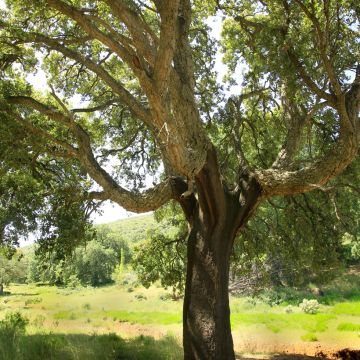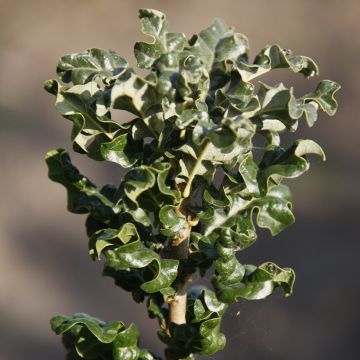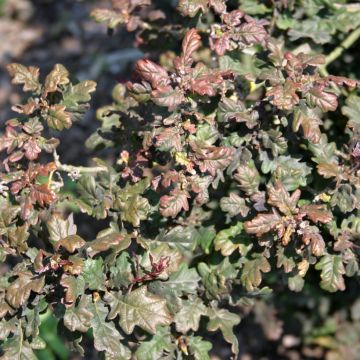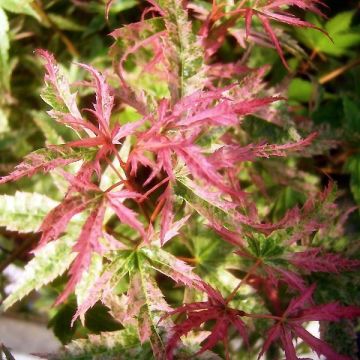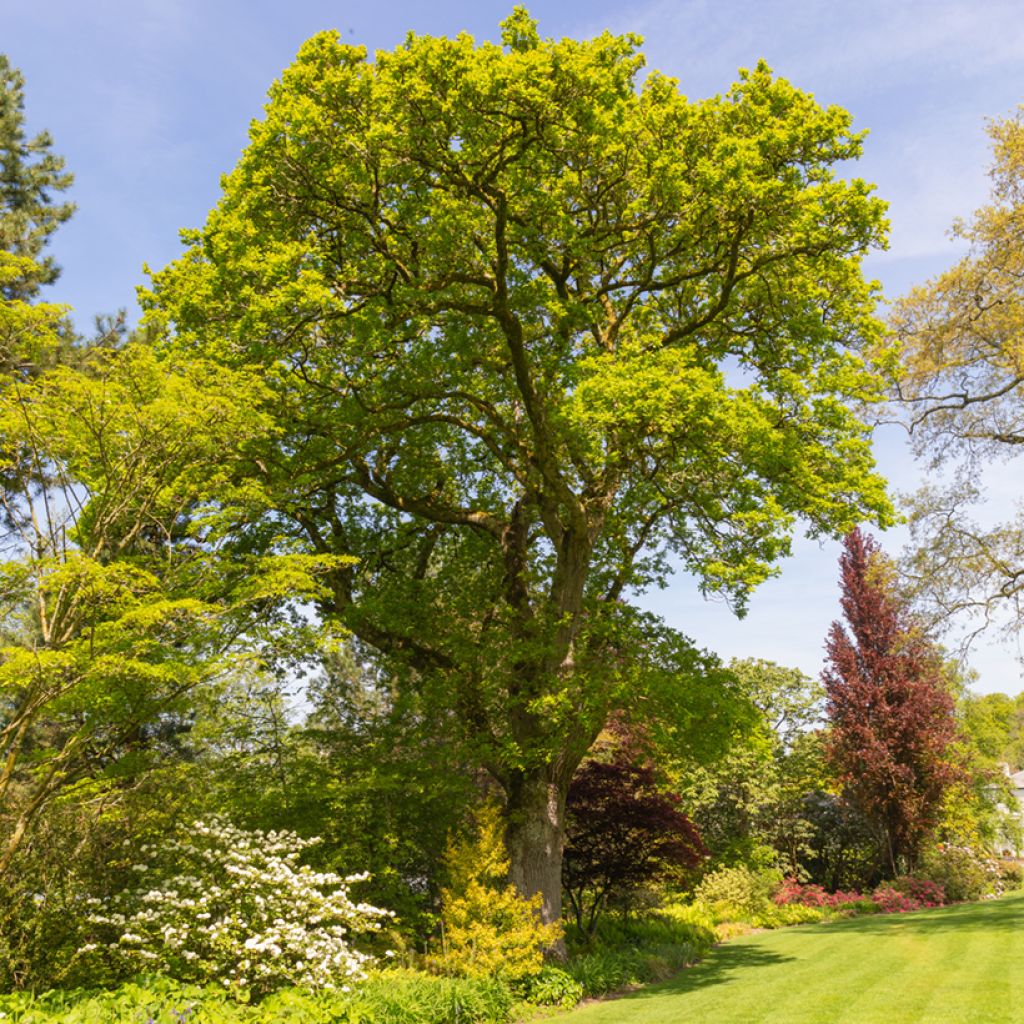

Quercus robur - English Oak


Quercus robur - English Oak


Quercus robur - English Oak


Quercus robur - English Oak


Quercus robur - English Oak


Quercus robur - English Oak


Quercus robur - English Oak


Quercus robur - English Oak
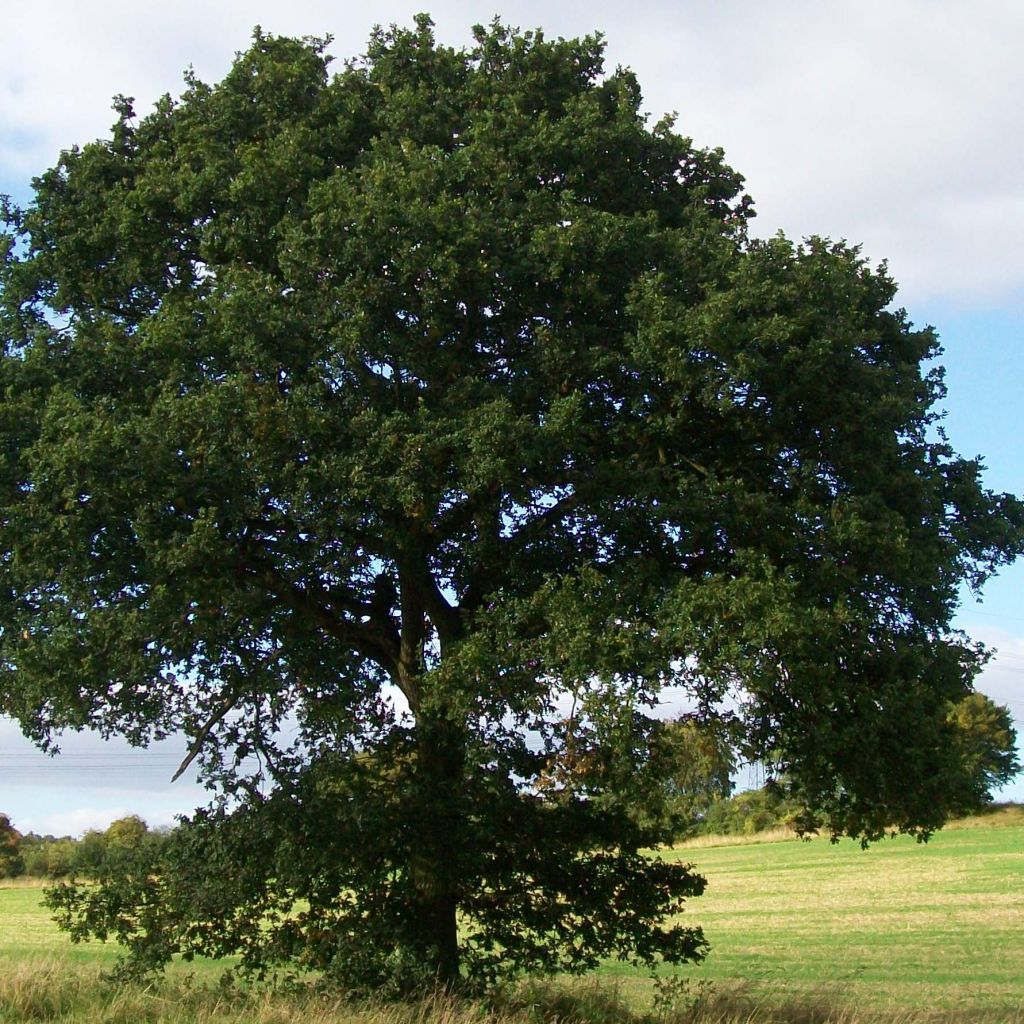

Quercus robur - English Oak
Quercus robur - English Oak
Quercus robur
English Oak, Common Oak, Pedunculate Oak
This item cannot be shipped to the selected country
Oversize package delivery charge from €6.90
Delivery charge from €5.90
Oversize package delivery charge from €6.90
Oversize package delivery charge from €6.90
Delivery to Corse prohibited
More information
Schedule delivery date,
and select date in basket
This plant carries a 24 months recovery warranty
More information
We guarantee the quality of our plants for a full growing cycle, and will replace at our expense any plant that fails to recover under normal climatic and planting conditions.
Oversize package: home delivery by special carrier from €6.90 per order..
Express home delivery from €8.90.
From €5.90 for pickup delivery and €6.90 for home delivery
Express home delivery from €8.90.
Oversize package: home delivery by special carrier from €6.90 per order..
Express home delivery from €8.90.
Oversize package: home delivery by special carrier from €6.90 per order..
Express home delivery from €8.90.
Delivery to Corse prohibited: UE law prohibits the import of this plant from mainland France to Corse as part of the fight against Xylella fastidiosa. Please accept our sincere apologies.
More information

Does this plant fit my garden?
Set up your Plantfit profile →
Description
Quercus robur, also known as the English Oak, common oak, or pedunculate oak, is a powerful and majestic tree that populates our forests in Europe. This noble species, has an irregular and airy crown, massive and tortuous branches located towards the bottom of the trunk, beautiful deciduous foliage that provides pleasant shade, and numerous acorns that delight small animals. Wide and tall, it grows faster than the sessile oak once established and can reach a venerable age. Perfectly adapted to our moderate climates, its large development requires plenty of room to grow in a spacious garden.
The English oak belongs to the Fagaceae family. It is native to a large part of temperate Europe. It appreciates sub-oceanic to oceanic climates, or continental climates without excess and relatively humid. In its natural environment, it can reach a height of 50 m (164 ft) with a span of 25 m to 30 m (82 ft to 98.4 ft), while its trunk can measure up to 2 m (6.6 ft) in diameter. In our gardens, it will reach an average height of 27 m (88.6 ft) with a spread of 20 m (65.6 ft). With a quite exceptional longevity, this oak can live up to 2000 years according to some estimates. Deciduous oaks have the advantage of producing good and abundant soil, favourable to the growth of plants that germinate under their cover.
The growth of this oak is moderately fast. Its habit is massive, slightly less wide than tall. The trunk, quite short, is covered with initially green and smooth bark, then becomes dark, thick, and deeply fissured. The crown is irregular, rounded, and open in shape. Its young branches are glabrous, grey-brown in colour, and shiny. The foliage, late deciduous, consists of alternate, soft, obovate leaves that can reach 5 cm to 15 cm (2 in to 5.9 in) long and 3 cm to 8 cm (1.2 in to 3.1 in) wide. Each leaf is divided into 5 to 7 pairs of asymmetrical rounded lobes, separated by relatively deep sinuses. The base of the lamina is narrow and has 2 small lobes. The colour of the lamina is a dark greenish-blue on the upper side, with the lower surface being paler. The leaves turn brown quite late in autumn, and remain slightly attached to the branches before falling. The flowering of this oak occurs in April-May, shortly after the appearance of the foliage, on annual shoots. The female flowers are placed in a cupule carried by a long peduncle: this distinctive characteristic is the origin of the species name, pedunculata. The male inflorescences are elongated, pendulous catkins, tinged with yellow. They are produced on older branches. The female flowers give way to ovoid and elongated acorns, measuring 1.5 cm to 3 cm (0.6 in to 1.2 in) in length. They are often grouped in pairs or threes and attached to a long peduncle. A cupule covered with scales covers one-third of the acorn. The colour changes from green to brown at ripeness, in September and October. The root system of this tree is deep and powerful, both taproot and extensively spreading, thus providing a solid and durable grip in deep and compact soils.
The English oak should be protected and preserved if it is spontaneously present in a park or a large garden, if only for the symbolism that surrounds an aged subject, a true keystone of an old garden. It can be planted either individually or in rows, in a very large garden. It also provides pleasant shade, which reflects light in winter. Its fruits, sometimes produced in abundance, feed small animals such as squirrels and jays. It can be planted with, for example, maples, plane trees, hackberries, lindens, and sophora in a large park.
Report an error about the product description
Quercus robur - English Oak in pictures


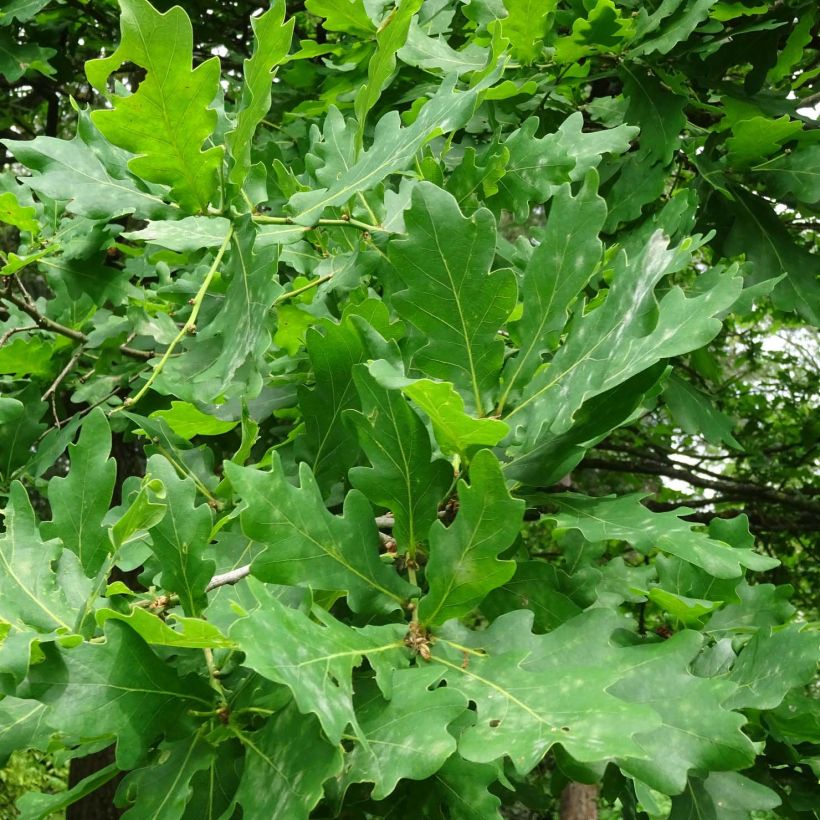

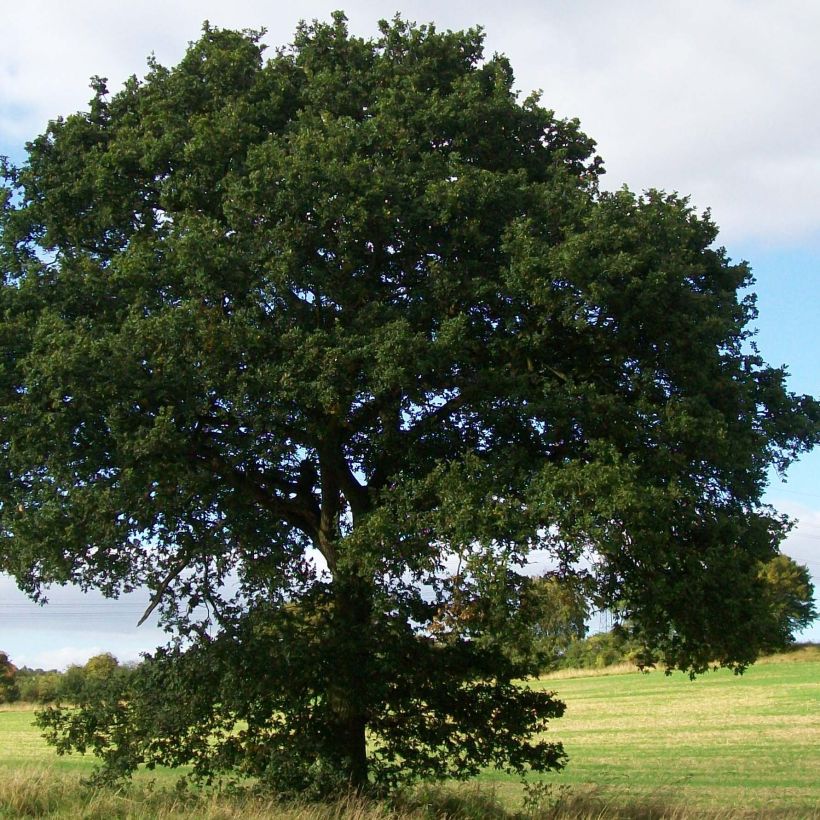

Plant habit
Flowering
Foliage
Botanical data
Quercus
robur
Fagaceae
English Oak, Common Oak, Pedunculate Oak
Western Europe
Other Oak
Planting and care
Quercus robur grows in ordinary but deep, preferably clayey, slightly calcareous, neutral or slightly acidic soil. Once established, this tree with deep anchorage can withstand normal summers and requires no watering. This oak succeeds almost everywhere, except in coastal areas. It appreciates moist but well-drained soils, where its growth will be faster. It prefers very sunny and open exposures. Place a sturdy stake to help it start, provide water, and then let nature take its course. It is a tree that, once installed, requires very little maintenance except for the removal of dead wood. It is not very prone to diseases. However, powdery mildew can affect its foliage.
Planting period
Intended location
Care
-
, onOrder confirmed
Reply from on Promesse de fleurs
Striking foliage shrubs
Haven't found what you were looking for?
Hardiness is the lowest winter temperature a plant can endure without suffering serious damage or even dying. However, hardiness is affected by location (a sheltered area, such as a patio), protection (winter cover) and soil type (hardiness is improved by well-drained soil).

Photo Sharing Terms & Conditions
In order to encourage gardeners to interact and share their experiences, Promesse de fleurs offers various media enabling content to be uploaded onto its Site - in particular via the ‘Photo sharing’ module.
The User agrees to refrain from:
- Posting any content that is illegal, prejudicial, insulting, racist, inciteful to hatred, revisionist, contrary to public decency, that infringes on privacy or on the privacy rights of third parties, in particular the publicity rights of persons and goods, intellectual property rights, or the right to privacy.
- Submitting content on behalf of a third party;
- Impersonate the identity of a third party and/or publish any personal information about a third party;
In general, the User undertakes to refrain from any unethical behaviour.
All Content (in particular text, comments, files, images, photos, videos, creative works, etc.), which may be subject to property or intellectual property rights, image or other private rights, shall remain the property of the User, subject to the limited rights granted by the terms of the licence granted by Promesse de fleurs as stated below. Users are at liberty to publish or not to publish such Content on the Site, notably via the ‘Photo Sharing’ facility, and accept that this Content shall be made public and freely accessible, notably on the Internet.
Users further acknowledge, undertake to have ,and guarantee that they hold all necessary rights and permissions to publish such material on the Site, in particular with regard to the legislation in force pertaining to any privacy, property, intellectual property, image, or contractual rights, or rights of any other nature. By publishing such Content on the Site, Users acknowledge accepting full liability as publishers of the Content within the meaning of the law, and grant Promesse de fleurs, free of charge, an inclusive, worldwide licence for the said Content for the entire duration of its publication, including all reproduction, representation, up/downloading, displaying, performing, transmission, and storage rights.
Users also grant permission for their name to be linked to the Content and accept that this link may not always be made available.
By engaging in posting material, Users consent to their Content becoming automatically accessible on the Internet, in particular on other sites and/or blogs and/or web pages of the Promesse de fleurs site, including in particular social pages and the Promesse de fleurs catalogue.
Users may secure the removal of entrusted content free of charge by issuing a simple request via our contact form.
The flowering period indicated on our website applies to countries and regions located in USDA zone 8 (France, the United Kingdom, Ireland, the Netherlands, etc.)
It will vary according to where you live:
- In zones 9 to 10 (Italy, Spain, Greece, etc.), flowering will occur about 2 to 4 weeks earlier.
- In zones 6 to 7 (Germany, Poland, Slovenia, and lower mountainous regions), flowering will be delayed by 2 to 3 weeks.
- In zone 5 (Central Europe, Scandinavia), blooming will be delayed by 3 to 5 weeks.
In temperate climates, pruning of spring-flowering shrubs (forsythia, spireas, etc.) should be done just after flowering.
Pruning of summer-flowering shrubs (Indian Lilac, Perovskia, etc.) can be done in winter or spring.
In cold regions as well as with frost-sensitive plants, avoid pruning too early when severe frosts may still occur.
The planting period indicated on our website applies to countries and regions located in USDA zone 8 (France, United Kingdom, Ireland, Netherlands).
It will vary according to where you live:
- In Mediterranean zones (Marseille, Madrid, Milan, etc.), autumn and winter are the best planting periods.
- In continental zones (Strasbourg, Munich, Vienna, etc.), delay planting by 2 to 3 weeks in spring and bring it forward by 2 to 4 weeks in autumn.
- In mountainous regions (the Alps, Pyrenees, Carpathians, etc.), it is best to plant in late spring (May-June) or late summer (August-September).
The harvesting period indicated on our website applies to countries and regions in USDA zone 8 (France, England, Ireland, the Netherlands).
In colder areas (Scandinavia, Poland, Austria...) fruit and vegetable harvests are likely to be delayed by 3-4 weeks.
In warmer areas (Italy, Spain, Greece, etc.), harvesting will probably take place earlier, depending on weather conditions.
The sowing periods indicated on our website apply to countries and regions within USDA Zone 8 (France, UK, Ireland, Netherlands).
In colder areas (Scandinavia, Poland, Austria...), delay any outdoor sowing by 3-4 weeks, or sow under glass.
In warmer climes (Italy, Spain, Greece, etc.), bring outdoor sowing forward by a few weeks.



































